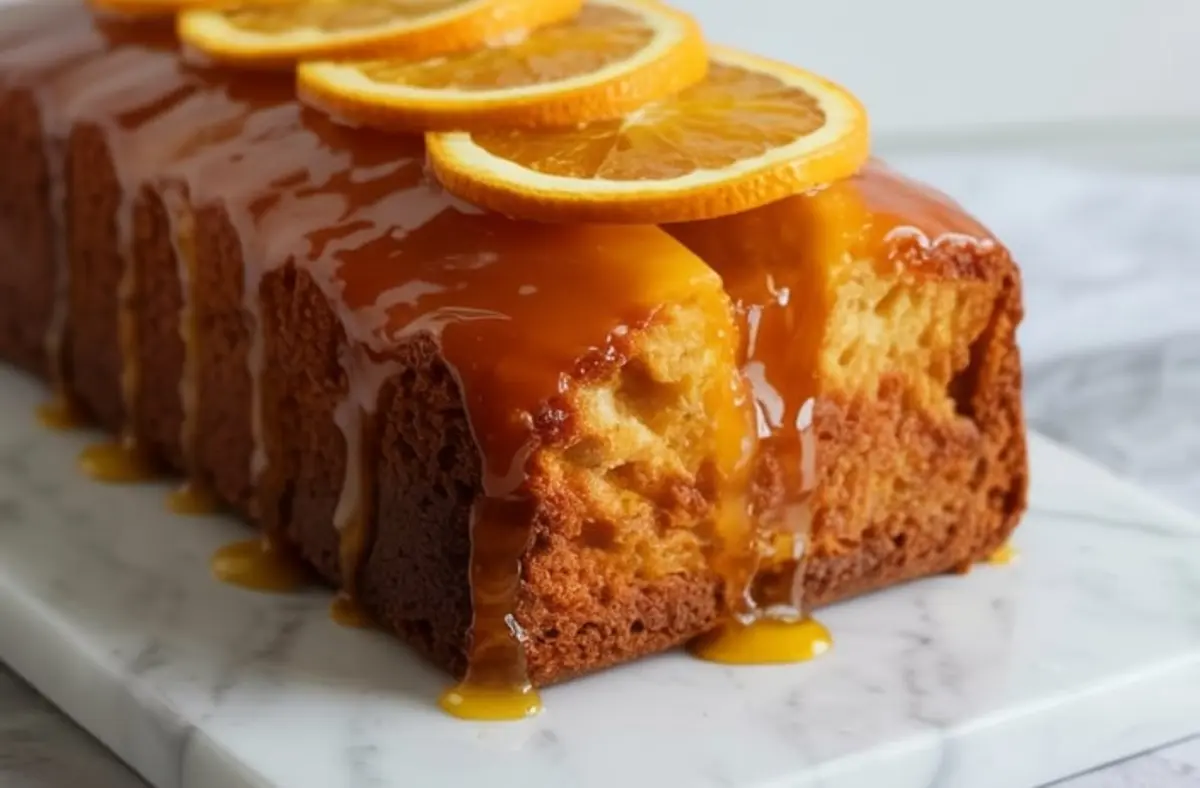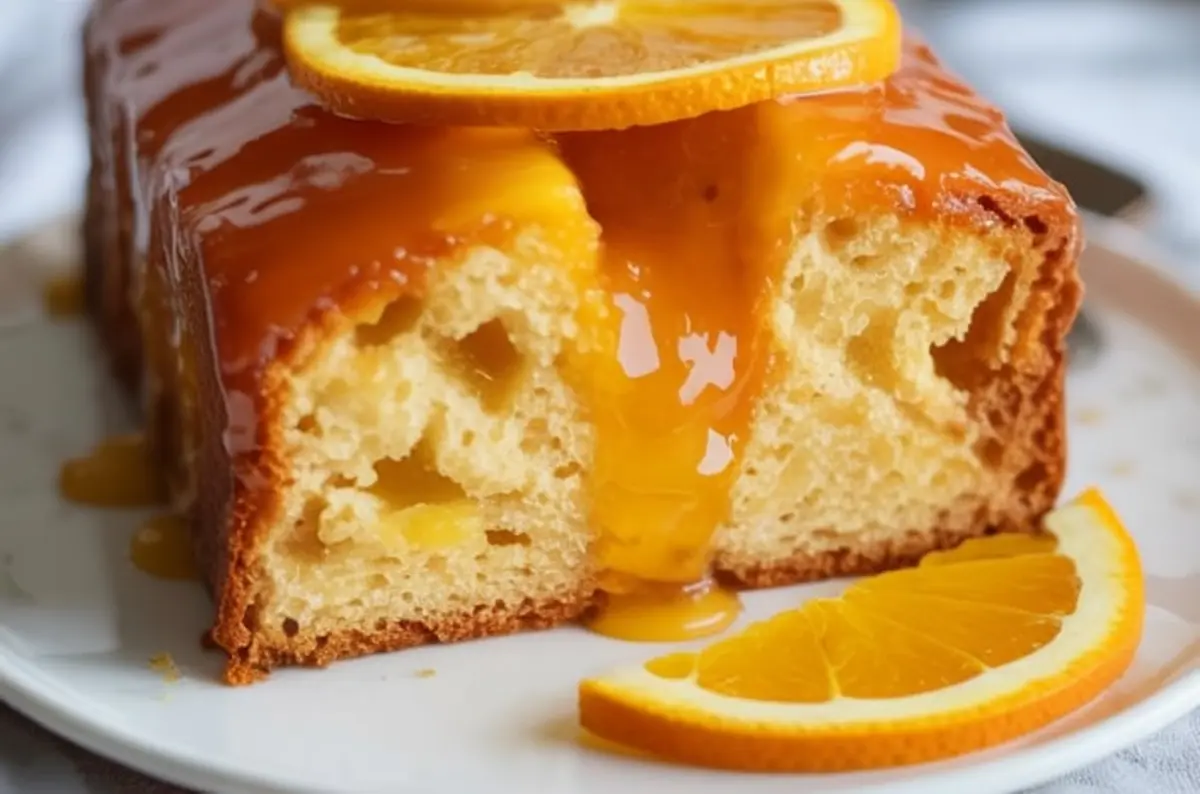This Christmas Orange Syrup Cake brings together a soft butter cake, fresh citrus zest and juice, and a warm orange syrup that soaks into every slice. The texture stays tender, never soggy. The flavor lands between an orange juice cake and the moist orange cakes you’ll find in Persian desserts. I make it for gatherings when I want something simple but standout. It fits right in with citrus desserts and orange syrup cake ideas for the holidays.

The 1:1:1 ratio of butter, sugar, and flour keeps the base sturdy but soft. Self-raising flour lifts the cake without extra leavening. Fresh zest and juice balance the richness. One orange’s juice goes into the batter, two more into the syrup. This step-by-step approach gives you control and consistency.
Other cakes made with oil or yogurt lose their crumb too easily. This version holds shape when sliced and stays moist on the second and third day. It isn’t dense. It isn’t dry. It’s balanced.
These Mini Christmas Drip Cakes follow a similar method if you prefer individual servings.
The Syrup Brings It Together

The syrup builds flavor without overwhelming the cake. Warm orange juice melts granulated sugar with a bit of zest. It doesn’t need a hard boil. Just a soft simmer for 2–3 minutes until glossy. Pour it slowly over the hot cake while still in the tin. That part matters. The warmth allows the sponge to soak in the liquid gradually.

If you rush this, the syrup just sits on top. Letting the cake rest 30 minutes in the tin helps it absorb fully. I never skip this part. Fresh juice matters more than you’d think. The bottled kind dulls the whole flavor.
Try this method in a deeper spiced format with these Gingerbread Cake Truffles.
Why These Ingredients Work

Softened unsalted butter beats cleanly with caster sugar. Room temperature eggs prevent curdling and blend faster. I use zest from two oranges and juice from three total. Zest lifts the batter, juice softens it. Vanilla gives depth. Salt sharpens every flavor.

If self-raising flour isn’t available, mix 200g plain flour with 2 teaspoons baking powder. It works, but the crumb turns slightly coarser. I still prefer the cleaner rise of the original.
A spoonful of flour stirred in when the eggs go in helps avoid splitting. Small tip, big difference.
For a decorated take on seasonal cakes, visit this Christmas Cake Idea.
How to Bake It Right

Cream the butter and sugar for 2–3 minutes until pale and fluffy. Add the eggs one at a time. Don’t rush. Once smooth, fold in the zest, juice, vanilla, and sifted flour with a pinch of salt. The batter should look smooth, never runny.
Bake at 160°C fan for 45 minutes. At 30 minutes, check the top. If it browns fast, place foil over the tin lightly. Use a skewer to test doneness. It should come out clean from the center.
While the cake bakes, make the syrup. Once baked, poke holes all over the hot cake and spoon the syrup over in several passes. Let it sit for 30 minutes before turning out to cool.
If you prefer a more playful format, try these Cookie Tree Dippers which use citrus in a different texture entirely.
Signs It’s Done

The cake’s surface should bounce back when lightly pressed. A clean skewer from the center means it’s baked through. If it looks pale or damp in the center, it needs more time. If the edges pull away too early, it’s gone too far. Trust the texture. That tells you more than the clock.
Variations Worth Trying
Swap the oranges for blood oranges or clementines. Add 1 tsp ground cardamom to bring a Persian twist. Almond extract instead of vanilla changes the depth. You can even slice it and layer with whipped cream for a chilled Christmas dessert.
Melted dark chocolate drizzled on top adds contrast. Or toast some flaked almonds and scatter them across the syrup-soaked surface before serving.
Save This Recipe and Share Your Take
Pin this Christmas Orange Syrup Cake to your holiday board so you have it ready when the season comes back around. I’d love to hear your tweaks. Share in the comments how it turned out or what variation you tried.
Christmas Orange Syrup Cake

This Christmas Orange Syrup Cake is soft, fragrant, and soaked in a glossy orange syrup that keeps every slice perfectly moist. Made with fresh citrus juice and zest, this moist orange cake delivers bright flavor and a tender crumb. Whether served warm or chilled, it’s a standout among Persian desserts, orange recipes, and festive citrus desserts. Perfect as a simple holiday table centerpiece or a sweet option for winter gatherings, this orange cake recipe uses whole fruit for extra richness, making it more than just another orange juice cake.
Ingredients
- FOR THE CAKE:
- 200g unsalted butter, softened
- 200g caster sugar
- 3 large eggs
- 200g self-raising flour
- Zest of 2 oranges
- Juice of 1 orange
- 1 tsp vanilla extract
- Pinch of salt
- FOR THE ORANGE SYRUP:
- 100ml freshly squeezed orange juice (about 2 oranges)
- 100g granulated sugar
- 1 tsp orange zest
- TO GARNISH:
- Thinly sliced fresh orange rounds (optional)
Instructions
- PREPARE THE CAKE BATTER: Preheat the oven to 160°C (fan) or 180°C (conventional). Grease and line a 9x5 inch loaf tin. In a large mixing bowl, beat the softened butter and caster sugar together until pale and fluffy, about 2–3 minutes with an electric mixer. Add the eggs one at a time, mixing well after each. If the mixture starts to curdle, mix in a spoonful of the flour. Stir in the orange zest, juice, and vanilla extract. Sift in the flour and salt, and fold the mixture gently until just combined.
- BAKE: Spoon the batter into the prepared tin and level the surface. Place on the middle rack of the oven and bake for 45–50 minutes. Check doneness with a skewer inserted in the center. If it comes out clean, the cake is ready. If the top browns too quickly, loosely cover with foil after 30 minutes.
- MAKE THE ORANGE SYRUP: While the cake bakes, stir together the orange juice, granulated sugar, and zest in a small saucepan. Warm over low heat until the sugar dissolves. Bring to a gentle simmer and cook for 2–3 minutes. Remove from heat and set aside.
- SOAK THE CAKE: Remove the baked cake from the oven. Use a skewer or fork to poke small holes all over the top. Slowly spoon the warm syrup over the surface, allowing it to absorb gradually. Let the cake sit in the tin for at least 30 minutes. Then turn out onto a wire rack and allow it to cool completely.
- GARNISH AND SERVE: Arrange thin orange slices over the top before serving, if desired. Spoon over any extra syrup if saved. Slice and serve once completely cooled.
Notes
The cake can be made a day in advance and stored at room temperature in an airtight container. The flavor improves as the syrup continues to soak in. Use unwaxed oranges for best flavor and safety when using zest.
Nutrition Information
Yield
10Serving Size
1Amount Per Serving Calories 368Total Fat 18gSaturated Fat 11gUnsaturated Fat 7gCholesterol 99mgSodium 149mgCarbohydrates 48gFiber 1gSugar 32gProtein 4g

